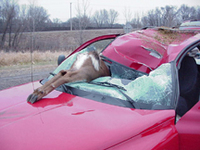Deer-Vehicle Collision Frequency Jumps 18 Percent in Five Years
 |
WEST VIRGINIA CONTINUES TO LEAD COLLISION LIKELIHOOD LIST
BLOOMINGTON, IL - September 28, 2009: The number of vehicles on U.S. roadways has grown by 7 percent over the last five years. But the number of times those vehicles have collided with deer has swelled by much more than that.
Using its claims data, State Farm, estimates 2.4 million collisions between deer and vehicles occurred in the U.S. during the two-year period between July 1, 2007 and June 30, 2009 (100,000 per month). That's 18.3 percent more than five years earlier. To put it another way, one of these unfortunate encounters occurs every 26 seconds (although they are much more likely during the last three months of the year and in the early evening).
MORE DEER-VEHICLE COLLISIONS
Among the 35 states where at least 7,000 deer-vehicle collisions occur
per year (we are not including the percentage changes in the other 15
states plus D.C. because the lower volume of total collisions makes the
percentage changes less credible), New Jersey and Nebraska have posted the
largest increases, 54 percent. Kansas is next at 41 percent. Deer-vehicle
collisions have jumped by 38 percent in Florida, Mississippi and Arkansas.
Then come Oklahoma (34 percent) and West Virginia, North Carolina and Texas
(33 percent).
LIKELIHOOD OF DEER-VEHICLE COLLISIONS
For the third year in a row, West Virginia tops the list of those states
where a collision with a deer is most likely (for any one vehicle). Using
its claims data in conjunction with state motor vehicle registration counts
from the Federal Highway Administration, State Farm calculates the chances
of a West Virginia vehicle striking a deer over the next 12 months at 1 in
39. Such an encounter is even more likely in West Virginia than it was a
year ago.
Michigan remains second on that list. The likelihood of a specific vehicle striking a deer there is 1 in 78. Pennsylvania (1 in 94) and Iowa (1 in 104) remain third and fourth respectively. Montana (1 in 104) moved up three places to fifth.
Arkansas and South Dakota each dropped a spot to sixth and seventh. Wisconsin remains eighth. North Dakota and Virginia round out the top 10.
The state in which deer-vehicle collisions are least likely is still Hawaii (1 in 9,931). The odds of any one vehicle hitting a deer in Hawaii during the next year are roughly equivalent to the odds of randomly picking a piece of clover and finding it has four leaves.
The average property damage cost of these incidents was $3,050, up 3.4 percent from a year ago.
According to the Insurance Institute for Highway Safety, deer-vehicle collisions in the U.S. cause more than 150 fatalities each year.
AVOIDING DEER-VEHICLE COLLISIONS
These collisions are more frequent during the deer migration and mating
season in October, November and December. The combination of growing deer
populations and the displacement of deer habitat caused by urban sprawl are
producing increasingly hazardous conditions for motorists and deer.
Here are tips on how to reduce the chances that a deer-vehicle collision involving your vehicle will be part of the story we tell in next year's version of this news release:
-- Be aware of posted deer crossing signs. These are placed in active
deer crossing areas.
-- Remember that deer are most active between 6 and 9 p.m.
-- Use high beam headlamps as much as possible at night to illuminate the
areas from which deer will enter roadways.
-- Keep in mind that deer generally travel in herds - if you see one,
there is a strong possibility others are nearby.
-- Do not rely on car-mounted deer whistles.
-- If a deer collision seems inevitable, attempting to swerve out of the
way could cause you to lose control of your vehicle or place you in
the path of an oncoming vehicle.


